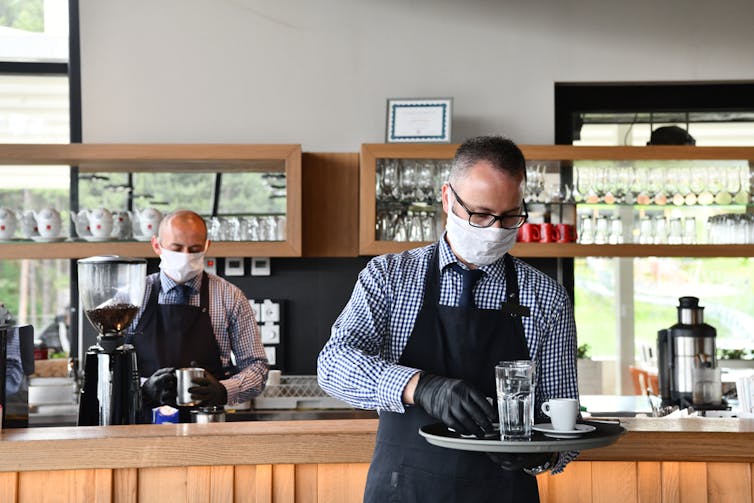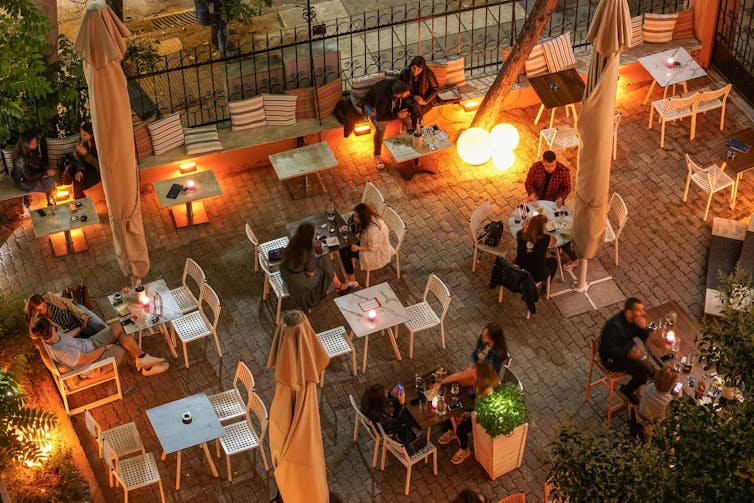Follow Focus/Shutterstock
COVID-19 has had a devastating effect on the restaurant industry. While a few restaurants have found ways to provide takeaway and dine-at-home offerings, the majority of businesses have shut up shop during lockdown.
From July 4, restaurants in the UK are permitted to open – but dining out will be very different. Here are seven ways in which social distancing and the wider impact of COVID-19 will change the restaurant industry.
Low customer numbers
A social distancing rule of one metre means restaurants can operate at a capacity level of 70%. Furthermore, a recent opinion poll showed that just 18% of consumers intend to visit restaurants, bars and pubs within a week of opening – although 44% said they intended to visit within a few weeks.
Lower customer numbers pose a significant challenge if businesses are to remain financially viable. Operators may consider adjusting prices to increase revenues, but must do so cautiously. Rewarding loyalty, enhancing service and product quality can give customers more for their money and still protect long-term profits.
New hygiene measures
Food safety and hygiene practices are not new to food businesses. Now, however, hygiene practices will need to form a key part of the meal experience in order to develop customer confidence, as well as preventing the spread of infection.

dotshock/Shutterstock
New measures may include the introduction of physical barriers and the use of protective equipment, disposable menus and the collection of contact details. Operators will need to think carefully how to make these interventions part of the dining experience. When a smile is hidden behind a face mask, waiting staff will have to use new ways to convey a warm welcome.
Local over city centre
Travel restrictions and a rise in home working has led people to turn to their local restaurants for home dining offers. Even as restrictions are lifted, many will continue working from home and a general reluctance to travel apart from for essential needs is likely to remain. So local restaurants are likely to continue benefiting from local patronage, while city centre restaurants may experience a slower growth in diners.
A different meal experience
As well as consuming great food and drink, dining out is all about providing experiences to customers that cannot be achieved at home – but these experiences will be very different under distancing measures. Service interactions will be limited and diners are likely to be served by just one employee.
More of the service process will involve technology, such as ordering through a smart phone. Restaurants will be quieter, at least in the short term, so the atmosphere and ambience may seem lacking. Customer levels will have to be managed carefully and we are likely to see far fewer walk-in opportunities, with advance reservations becoming the norm.
Changing menus
Full-service restaurants – sit-down eateries with dedicated waiting staff – have historically fared far worse during economic recessions than limited-service restaurants, where customers pay up front and collect their own food. Limited-service businesses often have lower overheads and pass the savings on through more affordable menus. Cash-strapped people turn to cheaper dining options rather than ceasing dining out altogether.

Bestravelvideo/Shutterstock
In response, we are likely to see full-service and fine-dining establishments consider introducing more affordable menu options. For instance, the economic crash of 2008 led to the £20 Michelin starred meal. While we may not see discounting to this level, operators will need to consider how best to attract increasingly money-conscious customers in the coming months and years. These restaurants may also consider offering simplified and reduced menus.
More takeaways
Many restaurants have already turned their attention to providing takeaways and ready meals to cook at home. This trend is not likely to disappear any time soon as risks of further lockdowns persist and customers may remain cautious about going out to eat.
The growth of delivery platforms such as Deliveroo has significantly changed our perspective of the restaurant and access to it, enabling people to experience restaurant-quality meals from the comfort of their own home.
Restaurant closures
After the 2008 recession, restaurant sales did not fully recover until 2016. Now, another economic recession appears inevitable for the UK, with GDP shrinking by an unprecedented 10.4% in the three months to April 2020.
Almost one-third of operators anticipate that they may need to close sites and sadly many restaurants have already permanently closed. More are likely to follow suit, especially when facing restricted revenues due to social distancing. If people want their favourite restaurants to remain open, they need to support them as best they can.
Restaurants will need to find opportunities where they can. Focusing on delivering a great dining experience, safely and with exceptional value will be essential, as diners look for relief from life’s challenges and to simply enjoy a night out once again.
![]()
James Ellerby does not work for, consult, own shares in or receive funding from any company or organisation that would benefit from this article, and has disclosed no relevant affiliations beyond their academic appointment.











